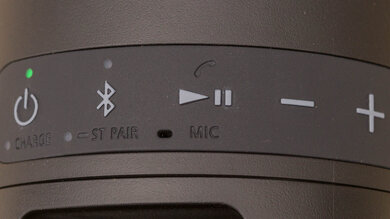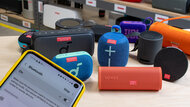The Sony SRS-XB13 is a small, budget-friendly portable speaker. It's the next generation of the Sony SRS-XB12, and much like its predecessor, it comes with a carrying strap, so you can easily carry it around with you when you're on the go. While it can't get very loud, there are few compression artifacts at max volume, so your audio sounds clean at louder volumes. It also has a wide-sounding soundstage and a somewhat boomy sound profile that adds some extra bass to the mix. However, like most small speakers we've tested, it still struggles to reproduce low-bass, so you can't feel the thump and rumble in bass-heavy music like hip-hop. It also doesn't come with a graphic EQ you can use to adjust its sound.
Our Verdict
The Sony SRS-XB13 isn't bad for music. It has a relatively boomy sound profile with a balanced mid-range that ensures vocals and lead instruments sound clear and present in the mix. That said, like most small speakers, it struggles to reproduce low-bass, so you can't feel the thump and rumble in bass-heavy music. It also doesn't get very loud and downmixes stereo content to mono, which may not sound as immersive. It can play stereo content when paired to another unit, but we don't test it as this requires purchasing another device.
- Little compression at max volume.
- Fantastic directivity.
- Requires two units for stereo sound.
- No graphic EQ or presets.
The Sony SRS-XB13 is sub-par for videos and movies. It has low Bluetooth latency with iOS and Android devices, making it suitable for watching movies and videos, though some apps compensate for latency differently, so your experience may differ. Unfortunately, it struggles to reproduce low-bass, so you can't feel the thump and rumble in action-packed scenes, and there aren't any sound customization features you can use to tweak its sound. It also requires two units to play stereo sound, so it downmixes stereo content to mono when using it on its own, which isn't as immersive.
- Little compression at max volume.
- Low latency with iOS and Android.
- Doesn't get very loud.
- Requires two units for stereo sound.
- No graphic EQ or presets.
The Sony SRS-XB13 is decent for podcasts. This incredibly portable speaker has a balanced mid-range, so voices and dialogue are clearly and accurately reproduced. It also has outstanding directivity, meaning you can hear your audio clearly from most angles. Unfortunately, it doesn't get very loud. That said, there's little compression present at max volume, so your audio remains clean during louder listening sessions.
- Fantastic directivity.
- Doesn't get very loud.
The Sony SRS-XB13 is poor for voice assistants. As part of our methodology, we use recorded commands to test voice assistant capabilities. While it couldn't register these commands, even without any ambient noise, it could register commands from a normal speaking voice, though this isn't part of our testing process. That said, it has incredible directivity, meaning you can hear your assistants clearly from all angles.
- Fantastic directivity.
- Doesn't get very loud.
- Bad voice assistant performance.
The Sony SRS-XB13 is alright for outdoor use. While it can't get very loud, there aren't many compression artifacts present at max volume, so your audio sounds clean at louder volumes. This well-built speaker is incredibly portable and is rated IP67 for dust and water resistance, though we don't test for this. It also has fantastic directivity, so you'll perceive its soundstage as wide and open. Unfortunately, it struggles to reproduce the thump and rumble in low-bass, which may disappoint fans of bass-heavy music.
- Little compression at max volume.
- IP67 rating for dust and water resistance.
- Fantastic directivity.
- Doesn't get very loud.
- Requires two units for stereo sound.
- No graphic EQ or presets.
Check Price
Differences Between Sizes And Variants
The Sony SRS-XB13 comes in six color variants: Black, Light Blue, Coral Pink, Taupe, Powder Blue, and Lemon Yellow. We expect these variants to perform similarly. We tested the 'Black' variant, and you can find its label here.
If you come across any other variants, let us know in the discussions, and we'll update our review.
Popular Speaker Comparisons
The Sony SRS-XB13 is a small and well-built, budget-friendly speaker that's similar to its predecessor, the Sony SRS-XB12. While they have very similar designs and perform similarly in many regards, the Sony XB13 can produce deeper bass and has a better-balanced sound profile than the Sony XB12. It also has a small port on its bottom for its bass. That said, unlike its predecessor, it doesn't feature an AUX input. Unfortunately, unlike the higher-end models from Sony's SRS lineup, the Sony XB12 and XB13 don't have a companion app and don't have a graphic EQ or presets you can use to tweak their sound.
See also our recommendations for the best Bluetooth speakers, the best waterproof speakers, and the best speakers under $100.
The Sony SRS-XB13 and the Sony SRS-XB100 are very similar speakers with slight differences that might affect your preference between the two. They're both very portable, lightweight speakers, but the SRS-XB100 has a longer continuous battery life and slightly better low-frequency extension. It's also a bit better built and is compatible with the Sony Music Center app. That said, the SRS-XB13 has less compression at max volume and lower AV synchronization error. The latter will ensure that there's minimal lag between your audio and video if you like connecting to the speaker to watch YouTube videos or other video content.
The Sony SRS-XB13 is a better speaker than the JBL Clip 4. The Sony has a better-balanced sound profile that can produce a deeper low-bass than the JBL. It can get louder with fewer compression artifacts at max volume, resulting in cleaner audio at louder volumes, and it has a wider-sounding soundstage than the JBL. However, the JBL is somewhat better built and comes with a built-in carabiner hook, which can come in handy when you're on the move.
The Sony SRS-XB13 is a better speaker than the JBL Flip 5. The Sony is smaller and better built, with an IP67 rating for dust and water resistance, so it's fully dust-tight and immersible in up to a meter of water for 30 minutes. It can get louder than the JBL with less compression present at max volume and has a wider and more open-sounding soundstage. It also has a longer-lasting battery life that lasts over 11 hours, though this can vary depending on your usage. The JBL can produce a more extended low-bass and pair with other PartyBoost-compatible JBL speakers.
The Ultimate Ears WONDERBOOM 2 is a better speaker than the Sony SRS-XB13 overall. The Ultimate Ears can play stereo content without downmixing it to mono, is better-built, and can get louder than the Sony. That said, the Sony has fewer compression artifacts present at max volume and has lower Bluetooth latency with iOS and Android devices, though some apps compensate for latency differently, and your experience may differ.
Test Results

The Sony SRS-XB13 is a small, lightweight speaker, with a very similar design to its predecessor, the Sony SRS-XB12. It comes with a carrying strap, so you can easily attach it to your bag or hang it from a hook. We tested the 'Black' color variant, but you can also find it in 'Light Blue', 'Coral Pink', 'Taupe', 'Powder Blue', and 'Lemon Yellow'.
The Sony SRS-XB13 is incredibly portable. This small and lightweight speaker is battery-powered and comes with a carrying strap, so you can easily carry it in one hand and take it with you when you're out and about.
The Sony XB13 has very good build quality. This speaker is mostly plastic, sits vertically, and has a small port on its bottom for the bass. There's also a metal grille on top of the speaker to protect its driver. Like the Sony SRS-XB12, it's rated IP67 for dust and water resistance, though we don't currently test for this. That said, the manufacturer warns that the speaker isn't designed to resist water pressure, so it's best to avoid using it in areas like under your shower. They also advise ensuring the cap protecting its USB-C port is tightly sealed to avoid the deterioration of its dust and water resistance performance.
The Sony SRS-XB13 has very good texturized controls at the bottom of the speaker that are pretty straightforward to use. You can use the play/pause button to answer and end phone calls, double press it to skip to your next track, and triple-press it to backtrack. To enter pairing mode, press the Bluetooth button. Connecting or disconnecting from the speaker causes it to emit a chime. You can also press and hold the Bluetooth button to connect it to another compatible speaker to create a stereo pair. Also, while there isn't any audible feedback to inform you of your volume level, the indicator light above the power button blinks three times when the speaker reaches its max volume level.
The Sony XB13's frequency response accuracy is passable. It has a somewhat boomy sound profile that adds a little extra bass to the mix. Its balanced mid-range ensures vocals and lead instruments are clearly and accurately reproduced in the mix. That said, while it can produce deeper bass than the Sony SRS-XB12, like most speakers its size, it struggles to reproduce low-bass, so you can't feel the thump and rumble in bass-heavy music. Unfortunately, there isn't a graphic EQ or presets you can use to tweak its sound to your liking.
This speaker's soundstage is good. It has fantastic directivity, resulting in a wide and natural-sounding soundstage. Unfortunately, it has to downmix stereo content to mono to play it, which doesn't sound as immersive. That said, you can connect it to another compatible speaker to create a stereo pair whenever you want to listen to stereo content.
This speaker's dynamics performance isn't bad. While it can't get very loud, there are few compression artifacts present at max volume, so your audio sounds clean at louder volume settings.
This speaker has an excellent battery performance. While the speaker is advertised to last up to 16 hours, it lasted under 12 hours in our tests, which is still superb. That said, battery life can vary depending on your usage habits and chosen settings, so your experience may differ. It also comes with a handy power-saving feature that shuts the Sony XB13 off when the speaker and its paired devices aren't operated for around 15 minutes.
The Sony SRS-XB13's voice assistant capabilities are very bad. Since it doesn't have any voice assistants built-in, it uses those available on your smartphone. We tested the speaker's voice assistant capabilities using recorded voice commands as part of our testing methodology. Unfortunately, much like the Sony SRS-XB12 and some other Sony speakers we've tested, the Sony XB13 didn't register or respond to these commands even when there wasn't any ambient noise present. That said, it could register some commands from a normal speaking voice, though this isn't part of our testing process.
The Sony XB13 has very good Bluetooth connectivity. If you're an Android user, you can quickly pair your phone to the speaker by placing them next to each other. When it's in pairing mode and your phone's Bluetooth is enabled, a notification should appear on your phone to connect it to the speaker quickly.
The Sony XB13 has low latency with Android and iOS devices, making it suitable for watching videos and movies over this connection. However, some apps compensate for latency differently, and your experience may vary. Unfortunately, you can only pair it to one device at a time, so you can't easily and quickly switch between audio sources.































